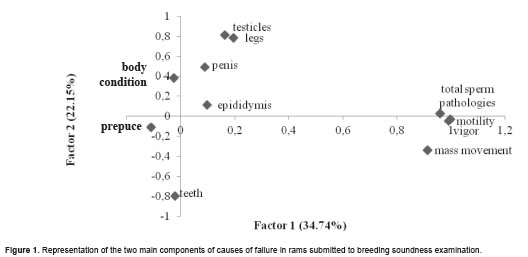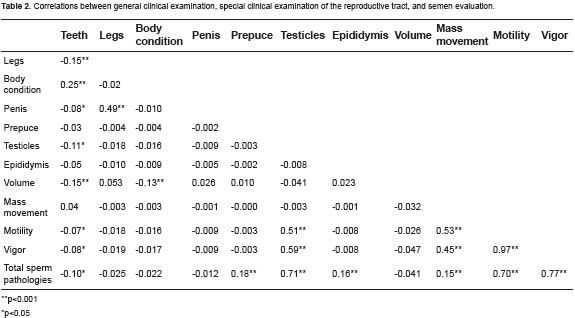Services on Demand
Journal
Article
Indicators
-
 Cited by SciELO
Cited by SciELO -
 Access statistics
Access statistics
Related links
-
 Cited by Google
Cited by Google -
 Similars in
SciELO
Similars in
SciELO -
 Similars in Google
Similars in Google
Share
Revista Colombiana de Ciencias Pecuarias
Print version ISSN 0120-0690
Rev Colom Cienc Pecua vol.27 no.2 Medellín Apri./June 2014
SHORT COMMUNICATION
Annual breeding soundness evaluation of rams ¤
Evaluación anual de la salud reproductiva en carneros
Avaliação anual da saúde reprodutiva nos carneiros
Silvio R Oliveira Menegassi1,2*, MV, MSc; Júlio O Jardim Barcellos1,2, MV, DSc; Celso Koetz Júnior3, MV, MSc; Vanessa Peripolli1,2,Zoot, MSc; Maria E Andrighetto Canozzi1,2,MV, MSc; Concepta McManus1,2, Zoot, Pós-doc; Flávio Guiselli Lopes3, MV, DSc.
* Corresponding author: Silvio R Oliveira Menegassi. Departamento de Zootecnia, Universidade Federal do Rio Grande do Sul (UFRGS), Porto Alegre, RS, Brasil. Av. Bento Gonçalves, 7.712 – 91540-000 – Porto Alegre, RS, Brasil. Email: programa.paat@gmail.com
1Departamento de Zootecnia, Universidade Federal do Rio Grande do Sul (UFRGS), Porto Alegre, RS, Brasil.
2Núcleo de Estudos em Sistemas de Produção de Bovinos de Corte e Cadeia Produtiva (NESPRO), Departamento de Zootecnia, Universidade Federal do Rio Grande do Sul (UFRGS), Porto Alegre, Rio Grande do Sul, Brasil.
3Faculdade de Medicina Veterinária, Universidade Norte do Paraná (UNOPAR), Arapongas, Paraná, Brasil.
(Received: February 8, 2012; accepted: November 7, 2013)
Summary
Background: breeding soundness evaluation (BSE) of males is crucial for reproductive success in sheep production systems. Objective: to determine the causes of failure when annual BSE was used to evaluate reproductive performance of rams. Methods: we analyzed 1,017 reproductive assessment records and assigned animals to young or mature groups. Animals were classified as approved or failed in the BSE. Statistical analyses were performed through Chi-square tests, correlation, and factor analyses. Results: our results clearly show the importance of regularly performing BSE to detect potential failures in rams that might reduce general fertility rates. Conclusions: consistent physical causes of failure were identified, and fertility rates varied according to age and year of examination.
Key words: fertility, ovine, reproductive evaluation.
Resumen
Antecedentes: la evaluación de la aptitud reproductiva (AR) del macho es crucial para el éxito reproductivo en los sistemas de producción ovina. Objetivo: determinar las causas de rechazo de carneros en el examen de la aptitud reproductiva. Métodos: fueron analizados 1017 registros de evaluación reproductiva de carneros clasificados como jóvenes y maduros. Los animales fueron clasificados como aprobados o no en el AR. Los análisis estadísticos incluyeron prueba de chi-cuadrado, correlaciones y análisis de los factores. Resultados: nuestros resultados demuestran claramente la importancia de la realización periódica del AR, ya que hubo una reducción en las tasas generales de los rechazos después de haber sido implementado. Conclusiones: se identificaron consistentes causas físicas de rechazo y las tasas de la fertilidad variaron según la edad y el año del examen.
Palabras clave: evaluación reproductiva, fertilidad, ovino.
Resumo
Antecedentes: a avaliação da aptidão reprodutiva (AR) do macho é crucial para o sucesso dos sistemas de produção ovina. Objetivo: determinar as causas de reprovação de carneiros na AR. Métodos: 1.017 registros de AR de carneiros jovens a adultos foram avaliados. Os animais foram clasificados como aprovados ou reprobados no AR. Os dados foram analisados por qui-quadrado, correlação e análise de fatores. Resultados: ficou demontrado claramente a importância da realização periódica da AR uma vez que houve redução nos índices gerais de reprovação após a implementação da AR. Conclusões: consistentes causas físicas de reprovação foram identificadas e os índices de fertilidade variaram segundo a idade e o ano do exame.
Palabras clave: evaluación reproductiva, fertilidad, ovino.
Introduction
Natural mating is the main breeding method in sheep production systems, and herd fertility efficiency depends essentially on ram and ewe reproductive performance. The Brazilian College of Animal Breeding published guidelines for breeding soundness examination (BSE), to be conducted before the breeding season in order to minimize breeding losses (CBRA, 1998). The reproductive success or failure of males can be measured quantitatively on a population basis or individually and should, where possible, be replicated over time using different criteria to estimate fertility and reproductive efficiency (Foote, 2003).
Periodical BSE identifies the main causes of ram failures, making it an important tool to increase reproductive efficiency of the herd. Thus, the aims of this work were to monitor rams for eight consecutive years using BSE and to measure the main causes of reproductive failure before the breeding season.
Materials and methods
Evaluated animals
A database consisting of 1,017 reproductive assessment records of Corriedale rams was evaluated. Animals were classified as young when they had never been used in mating systems (18 months) or mature rams if they had previous sexual experience (more than 18 months). Data were collected from 2003 to 2010 as shown in table 1. BSE were performed every year. Animals were maintained on adequate pastures with ad libitum access to water, and parasite control.
Breeding soundness evaluation
The BSE was performed according to the guidelines of CBRA (1998):
1. General clinical examination: eyes, teeth, body condition score, and leg conditions.
2. Clinical examination of the reproductive tract: prepuce, penis, scrotum, testicles.
3. Semen examination: motility, vigor, mass movement, sperm concentration and sperm morphology were performed using a phase-contrast microscope. Semen collection was performed using electroejaculation.
Statistical analyses
The Chi-square test was used to investigate the relationship of the binary variable (approval or failure) among 2003 to 2010 and age classes (young or mature).
Failure results were submitted to principal component analysis. Pearson's correlation coefficient among the evaluated parameters was also calculated.
All statistical analyses were conducted using the Statistical Analysis System software package.
Results
Interaction was found between age and year of reproductive failure; mature rams failed the BSE exam in 2003, 2005, 2007, 2008, 2009, and 2010; however, no difference was observed between ages during years 2004 and 2006 (Table 1).
Means followed by different small letters in the same column and different capital letters in the same row are statistically different by Tukey test (5% significance).
Failed = percent of excluded rams after annual BSE.
The main factors explain 34.74% of failures causes. When total sperm pathology increased, motility, vigor, and mass movement decreased along with an increase of testis, penis, epididymis and leg problems, and a decrease in body condition, along with teeth and foreskin problems. Secondary causes explained 22.15% of failures. When an increase was observed for problems related to body condition, testicles, penis, epididymis and sperm pathologies, a decrease was also observed for problems related to teeth, prepuce, motility, vigor, and mass movement (Figure 1).
A positive correlation was observed between teeth failure and body condition, and a negative correlation between legs and seminal volumes (Table 2). Physical aspects of the prepuce were positively correlated with sperm pathologies. We also found a positive correlation between testicles and motility, vigor and total sperm pathologies. However, epididymis alterations showed a positive correlation with the total sperm pathologies (p<0.001).
Discussion
BSE is considered an important tool to evaluate reproductive performance in different species, including rams. In the present study, consistent causes of failure were identified with rates varied according to age and year.
Kimberling and Butter (1986) found higher failure rates during BSE of mature rams than those observed in the present study. This variability could be explained by many factors, such as management practices, season when BSE was performed, and even the statistical analysis method applied (Amann, 2005).
In this study, the main causes of failure were physical—missing teeth, leg problems, poor body condition score, testicle hypoplasia, and epididymitis— and related with the ejaculate—motility, vigor, mass movement, and total pathologies—which is in agreement with findings by other researchers (Moraes et al., 1977; Ott and Memon, 1980). Maurya et al. (2010) concluded that breeding efficiency of rams is better when their body condition is adequate during the breeding season.
In the present study, the rates of failure at semen examination were high, despite not considering seasonal differences, as in the study of Karagiannidisa et al. (2000). When studying seasonal variations in semen production among rams within each breed, those authors found significant differences in semen quantity and quality. Moreover, Oberst et al. (2011), in a similar study with Lacaune rams, observed that, except for sperm concentration, all other semen characteristics presented seasonal variations. Consistent with the present study, Van Metre et al. (2012) found that 29.0% of the evaluated rams failed the BSE and the most common reason for failure was substandard semen parameters.
The importance of regular reproductive assessment is evident considering the results of this study and the cited literature. Breeding evaluation in rams was shown to be consistent, independently of the age of the animals. Physical and seminal problems were the main causes of failure, and their incidence varied between young and adult animals. A high number of rams failed the BSE when it was used routinely, demonstrating the importance of this annual exam to detect causes acquired during the mating season.
¤ To cite this article: Oliveira SR, Jardim JO, Koetz C, Peripolli V, Andrighetto ME, McManus C, Guiselli L. Annual breeding soundness evaluation of rams. Rev Colomb Cienc Pecu 2014; 27:133-137.
References
Amann RP. Weaknesses in report of fertility for horses and other species. Theriogenology 2005; 63:698-715. [ Links ]
Colegio Brasileiro de Reprodução Animal (CBRA). Procedimentos para exame andrológico e avaliação de sêmen animal. 2ª ed. Belo Horizonte: Colégio Brasileiro de Reprodução Animal; 1998. [ Links ]
Foote RH. Fertility estimation: a review of past experience and future prospects. Anim Reprod Sci 2003; 73:119-139. [ Links ]
Karagiannidisa A, Varsakeli S, Alexopoulosa C, Amarantidis I. Seasonal variation in semen characteristics of Chios and Friesian rams in Greece. Small Ruminant Res 2000; 37:125-130. [ Links ]
Kimberling C, Buttler J. Colorado's ram breeding soundness program. In: Proceedings of the 5th Annual Meeting of the WRCC-46 for Ram Epididymitis and Ovine Footrot Conference; June 20-21; Albuquerque, USA. Albuquerque (NM): Western Regional Coordinating Committee-46; 1986. p.41-47. [ Links ]
Maurya VP, Sejian V, Kumar D, Naqvi SMK. Effect of induced body condition score differences on sexual behavior, scrotal measurements, semen attributes and endocrine responses in Malpura rams under hot semi-arid environment. J Anim Physiol 2010; 94:308-317. [ Links ]
Van Metre DCV, Rao S, Kimberling CV, Morley PS. Factors associated with failure in breeding soundness examination of Western USA rams. Prev Vet Med 2012; 105:118- 126. [ Links ]
Moraes JCF, Silva JF, Schuch LH. Influência do macho na fertilidade do rebanho ovino inseminado artificialmente no Rio Grande do Sul. Ver Bras Reprod Anim 1977; 1:31-38. [ Links ]
Oberst ER, Smirdele WA, Brito MA, Marschner TR, Ribeiro LA, Mattos RC. Seasonal variation in semen quality of Lacaune rams in Brazil. Braz J Vet Res Anim Sci 2011; 48:319-324. [ Links ]
Ott RS, Memon MA. Breeding soudness examination of rams and bucks, a review. Theriogenology 1980; 13:155-164. [ Links ]
















